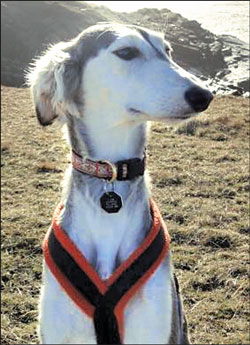Hard to trace ancient genetic roots of modern dogs
Cross-breeding of dogs over thousands of years has made it extremely
difficult to trace the ancient genetic roots of today's pets, according
to a new study led by Durham University.
An international team of scientists analysed data of the genetic
make-up of modern-day dogs, alongside an assessment of the global
archaeological record of dog remains, and found that modern breeds
genetically have little in common with their ancient ancestors.
|

Salukis appear genetically different because they were
geographically isolated and were not part of the 19th century
Victorian-initiated Kennel Clubs that blended lineages to create
most of the breeds we keep as pets today.
- Credit: Keith Dobney |
Dogs were the first domesticated animals and the researchers say
their findings will ultimately lead to greater understanding of dogs'
origins and the development of early human civilization. Although many
modern breeds look like those depicted in ancient texts or in Egyptian
pyramids, cross-breeding across thousands of years has meant that it is
not accurate to label any modern breeds as "ancient," the researchers
said.
Breeds such as the Akita, Afghan Hound and Chinese Shar-Pei, which
have been classed as "ancient," are no closer to the first domestic dogs
than other breeds due to the effects of lots of cross-breeding, the
study found. Other effects on the genetic diversity of domestic dogs
include patterns of human movement and the impact on dog population
sizes caused by major events, such as the two World Wars, the
researchers added.
The findings were published May 21 in the scientific journal
Proceedings of the National Academy of Sciences USA (PNAS). The
Durham-led research team was made up of scientists from a number of
universities including Uppsala University, Sweden, and the Broad
Institute, in the USA.
In total the researchers analysed genetic data from 1,375 dogs
representing 35 breeds. They also looked at data showing genetic samples
of wolves, with recent genetic studies suggesting that dogs are
exclusively descended from the grey wolf. Lead author Dr Greger Larson,
an evolutionary biologist in Durham University's Department of
Archaeology, said the study demonstrated that there is still a lot we do
not know about the early history of dog domestication including where,
when, and how many times it took place.
Dr Larson added: "We really love our dogs and they have accompanied
us across every continent.
"Ironically, the ubiquity of dogs combined with their deep history
has obscured their origins and made it difficult for us to know how dogs
became man's best friend.
"All dogs have undergone significant amounts of cross-breeding to the
point that we have not yet been able to trace all the way back to their
very first ancestors."Several breeds, including Basenjis, Salukis and
Dingoes, possess a differing genetic signature, which previous studies
have claimed to be evidence for their ancient heritage, the research
found.
However, the study said that the unique genetic signatures in these
dogs was not present because of a direct heritage with ancient dogs.
Instead these animals appeared genetically different because they
were geographically isolated and were not part of the 19th Century
Victorian-initiated Kennel Clubs that blended lineages to create most of
the breeds we keep as pets today.
The study also suggested that within the 15,000 year history of dog
domestication, keeping dogs as pets only began 2,000 years ago and that
until very recently, the vast majority of dogs were used to do specific
jobs.
Dr Larson said: "Both the appearance and behaviour of modern breeds
would be deeply strange to our ancestors who lived just a few hundred
years ago.
"And so far, anyway, studying modern breeds hasn't yet allowed us to
understand how, where and when dogs and humans first started this
wonderful relationship."
The researchers added that DNA sequencing technology is faster and
cheaper than ever and could soon lead to further insights into the
domestication and subsequent evolution of dogs.
ScienceDaily |

